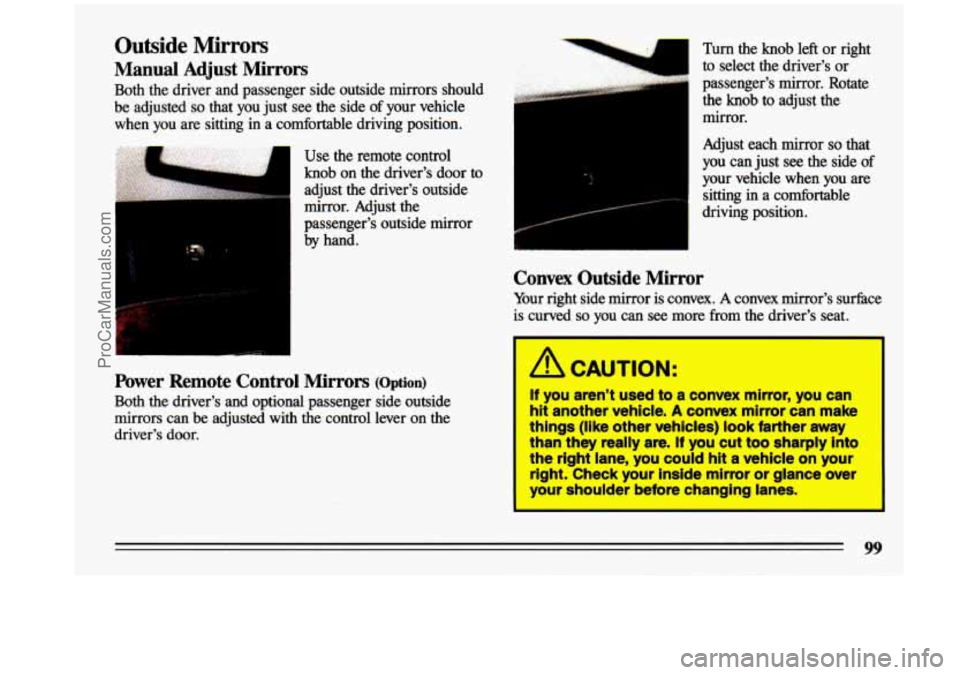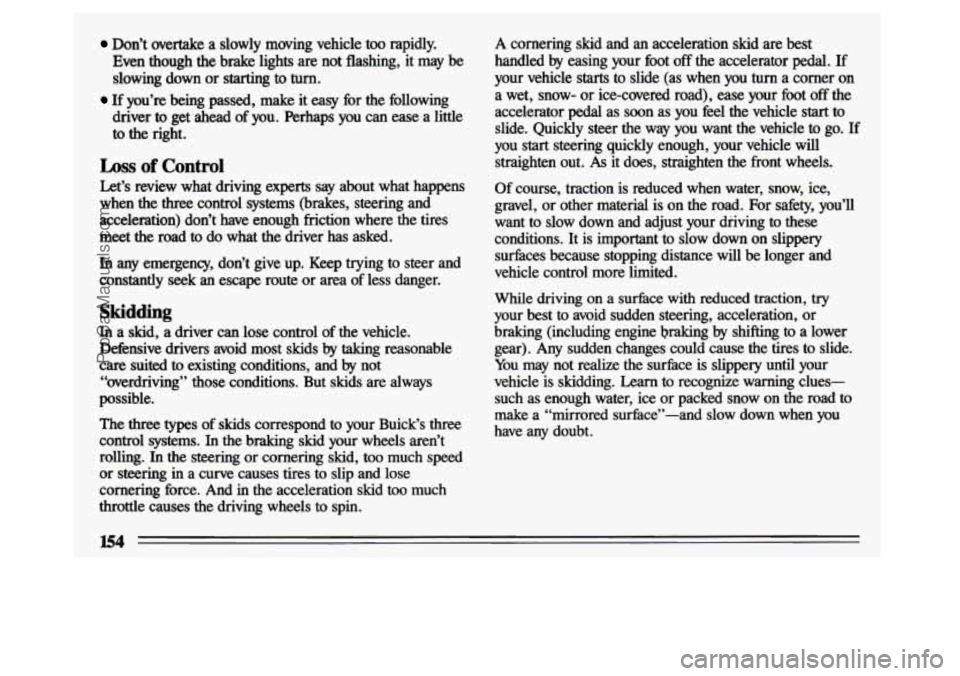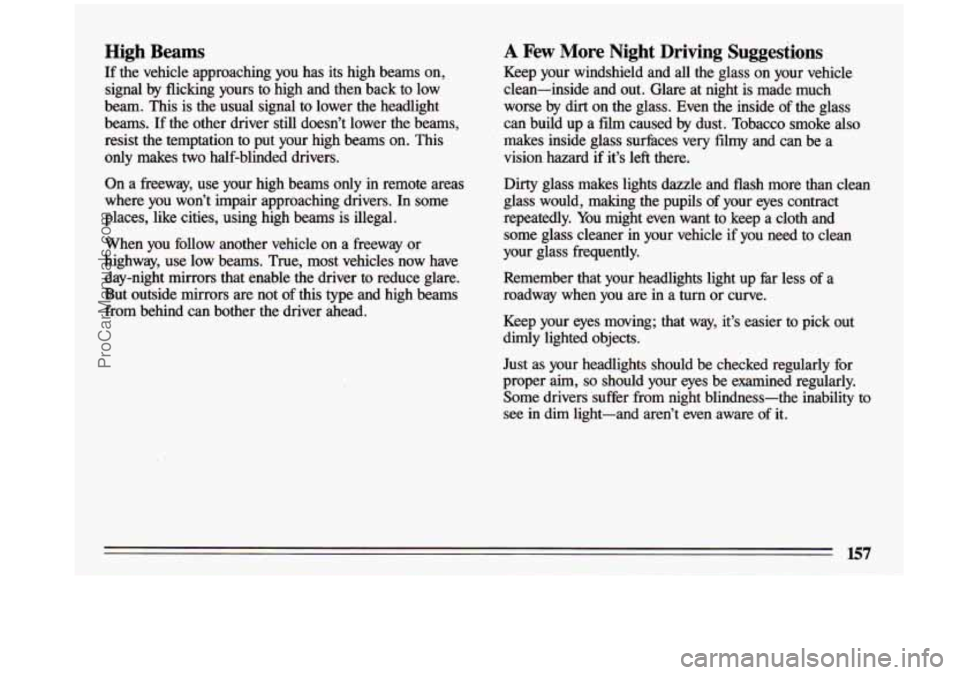1993 BUICK CENTURY mirror
[x] Cancel search: mirrorPage 65 of 324

n
part 2 Features and Controls
Here you can learn about the many standard and optional features on your Buick. and informat\
ion on starting.
shifting and braking . Also explained are the instrument panel and the warning systems that tell you if everything
is working properly-and what to do if you have a problem .
Part 2 includes:
Keys ........................................................................\
........
Locks ........................................................................\
...... 65
Remote Keyless Entry System ........................................................... 66
New Vehicle Break-In ................................................................. 72
Ignition ........................................................................\
..... 73
Starting Your Engine .................................................................. 74
Shifting the Transaxle ........................................... : ..................... 77
parking Brake ........................................................................\
80
ShiftingIntoPark ..................................................................... 81
Windows ........................................................................\
... 84
Horn ........................................................................\
....... 86
TiltSteeringWheel ................................................................... 86
Turn Signal/Headlight Beam Lever ....................................................... 86
Windshield Wipers, Washer ........................................................... 88
CruiseControl ..................................................................... 91
InteriorLights ....................................................................... \
95
Headlights ........................................................................\
.. 95
Mirrors ........................................................................\
..... 98
Instrument Panel ..................................................................... 105
Warning Lights, Gages and Indicators .................................................. 106
63
ProCarManuals.com
Page 100 of 324

Inside Rearview Mirror with Reading Lights
(Option)
Courtesy Lights
When any door is opened, several lights go on. These
lights are under the instrument panel. Optional lights are on the rear doors. They make it easy for you to enter and
leave the vehicle.
You also can turn these lights on by
rotating the interior lights switch to
‘‘HI:’
Mirrors
Inside Mirror
--
To reduce glare from lights behind you, pull the lever
toward you to the night position.
To turn on the reading lights, press the switches on the - -_ front of the mirror.
To reduce glare from lights behind you, pull the lever
toward you to the night position.
98
ProCarManuals.com
Page 101 of 324

Outside Mirrors
Manual Adjust Mirrors
Both the driver and passenger side outside mirrors should
be adjusted
so that you just see the side of your vehicle
when you are sitting in a comfortable driving position.
Use the remote control
knob on the driver’s door to adjust
the driver’s outside
mirror. Adjust the
passenger’s outside mirror
by hand. Turn the knob left
or right
to select the driver’s or
passenger’s mirror.
Rotate
the knob to adjust the
mirror.
Adjust each mirror
so that
you can just see the side
of
your vehicle when you are
sitting in a comfortable
driving position.
Power Remote Control Mirrors (Option)
Both the driver’s and optional passenger side outside
mirrors can be adjusted with the control lever on the
driver’s door.
Convex Outside Mirror
Your right side mirror is convex. A convex mirror’s surface
is curved
so you can see more from the driver’s seat.
A CAUTION:
If you aren’t used to a convex mirror, you can
hit another vehicle.
A convex mirror can make
thlngs
(like other vehlcles) look farther away
than they really are. If you cut too sharply into
the right lane, you could hit
a vehicle on your
right. Check your Inside mirror
or glance over
your shoulder
before changing lanes.
99
ProCarManuals.com
Page 102 of 324

Sun Visors Luggage Carrier (Option)
To block out glare, you can swing down the visors. If you have
the optional luggage carrier, you can load
Visor Vanity Mirrors vehicle. The luggage cairier has slats attached to the deck
things
on top of a wagon,
or on the deck lid of your
- . lid, a rear rail, and tiedowns. The wagon has slats
attached to the roof, side rails, and adjustable crossrails.
The crossrails can be adjusted by loosening the screws.
After moving the crossrails, be sure to tighten the screws
securely.
Standard Mirror: Open the cover to expose the vanity
mirror.
Lighted Mirrors: If your vehicle has the optional lighted
vanity mirrors, the lights come on when you open the
cover. These can even be used for reading. Close the
cover to
turn out the lights. Don’t exceed the maximum vehicle capacity when loading
your Buick. For more information on vehicle capacity and loading,
see “Loading Your Vehicle” in the Index.
100
ProCarManuals.com
Page 155 of 324

So here are some tips for passing:
“Drive ahead:’ Look down the road, to the sides, and
to crossroads for situations that might affect your
passing patterns. If you have any doubt whatsoever
about making a successful pass, wait for a better time.
Watch for traffic signs, pavement markings, and lines.
If you can
see a sign up ahead that might indicate a
turn or an intersection, delay your pass. A broken
center line usually indicates it’s
all right to pass
(providing the road ‘ahead is clear). Never cross a solid \
line on your side of the lane or a double solid line, even
if the road seems empty of approaching traffic.
If you suspect that the driver of the vehicle you want to
pass isn’t aware of your presence, tap the horn a couple
of times before passing.
Do not get too close to the vehicle you want to pass
while you’re awaiting
an opportunity. For one thing,
following too closely reduces your area
of vision,
especially if you’re following a larger vehicle. Also,
you won’t have adequate space if the vehicle ahead
suddenly slows or stops. Keep back a reasonable
distance.
When it looks like a chance to pass is coming up, start
to accelerate but stay in the right lane and don’t get too
close. Time your move
so you will be increasing speed
as the time comes to move into the other lane. If the
way is clear to pass,
you will have a “running start’’
that more than makes up for the distance you would
lose
by dropping back. And if something happens to
cause you to cancel your pass, you need only slow
down and drop back again and wait
for another
opportunity.
If other cars are lined up to pass a slow vehicle, wait
your turn. But take care that someone isn’t trying
to
pass you as you pull out to pass the slow vehicle.
Remember to glance over your shoulder and check the
blind spot.
start your left lane change signal before moving out of
the right lane to pass. When you are far enough ahead
of the passed vehicle to see its front
in your inside
mirror, activate your right lane change signal and move
back into
the right lane. (Remember that your right
outside mirror
is convex. The vehicle you just passed
may seem to be farther away from you
than it really is.)
Try not to pass more than one vehicle at a time on two-
lane roads. Reconsider before passing the next vehicle.
Check your mirrors, glance over your shoulder, and
ProCarManuals.com
Page 156 of 324

Don’t overtake a slowly moving vehicle too rapidly.
Even though the brake lights are not flashing, it
may be
slowing down or starting to turn.
driver to get ahead of you. Perhaps you can ease a little
to the right.
If you’re being passed, make it easy for the following
Loss of Control
Let’s review what driving experts say about what happens
when the three control systems (brakes, steering and
acceleration) don’t have enough friction where the tires
meet the road
to do what the driver has asked.
In any emergency, don’t give up. Keep trying to steer and
constantly
seek an escape route or area of less danger.
Skidding
In a skid, a driver can lose control of the vehicle.
Defensive drivers avoid most skids
by taking reasonable
care suited
to existing conditions, and by not
“overdriving” those conditions. But skids are always
possible.
The three types
of skids correspond to your Buick‘s three
control systems. In the braking skid your wheels aren’t
rolling.
In the steering or cornering skid, too much speed
or steering in a curve causes tires to slip and lose
cornering force. And
in the acceleration skid too much
throttle causes the driving wheels to spin.
I
A cornering skid and an acceleration skid are best
handled by easing your foot
off the accelerator pedal. If
your vehicle starts to slide (as when you turn a corner on
a wet, snow- or ice-covered road), ease your
foot off the
accelerator pedal as soon as you feel the vehicle start to
slide. Quickly steer the way you want the vehicle to go. If
you
start steering quickly enough, your vehicle will
straighten out. As it does, straighten the front wheels.
Of course, traction is reduced when water, snow, ice,
gravel, or other material is on the road.
For safety, you’ll
want to slow down and adjust your driving
to these
conditions. It is important to slow down on slippery
surfaces because stopping distance will be longer and
vehicle control more limited.
While driving on a surfhce
with reduced traction, try
your best to avoid sudden steering, acceleration, or
braking (including engine braking
by shifting to a lower
gear).
Any sudden changes could cause the tires to slide.
You may not realize the surface is slippery until your
vehicle is skidding.
Learn to recognize warning clues-
such as enough water, ice or packed snow on the road
to
make a “mirrored surface”-and slow down when you
have
any doubt.
154
ProCarManuals.com
Page 157 of 324

In a braking skid (where the wheels are no longer
rolling), release enough pressure on the brakes to get the
wheels rolling again.
This restores steering control. Push
the brake
pedal down steadily when you have to stop
suddenly.
As long as the wheels are rolling, you will have
steering control. Steer the way you want to go.
Driving at Night
Night driving is more dangerous than day driving. One
reason is that some drivers are likely to be impaired-by
alcohol or drugs, with night vision problems, or by fatigue.
Here are some tips on night driving.
Drive defensively. Remember, this is the most
dangerous time.
Don’t drink and drive. (See “Drunken Driving” in the
Index for more on this problem.)
Adjust your inside rearview mirror to reduce the glare
from headlights behind you.
Since you can’t see as well, you may need to slow
down and keep more space between you and other
vehicles. It’s hard to tell how fast the vehicle ahead is
going just by looking at its taillights.
Slow down, especially on higher speed roads. Your
headlights can light up only
so much road ahead.
In remote areas, watch for animals.
If you’re tired, pull off the road in a safe place and rest.
ProCarManuals.com
Page 159 of 324

High Beams
If the vehicle approaching you has its high beams on,
signal by flicking yours to high and then back to low
beam. This is the usual signal to lower the headlight
beams. If the other driver still doesn’t lower the beams,
resist the temptation to put your high beams on. This
only makes two half-blinded drivers.
On a freeway, use your high beams
only in remote areas
where you won’t impair approaching drivers.
In some
places, like cities, using high beams is illegal.
When you follow another vehicle on a freeway or
highway, use low beams. True, most vehicles now have
day-night mirrors that enable the driver to reduce glare.
But outside mirrors are not
of this type and high beams
from behind can bother the driver ahead.
A Few More Night Driving Suggestions
Keep your windshield and all the glass on your vehicle
clean-inside and out. Glare at night is made much
worse by dirt on the glass. Even the inside of the glass
can build up
a fdm caused by dust. Tobacco smoke also
makes inside glass surfaces very filmy and can be a
vision hazard
if it’s left there.
Dirty glass makes lights dazzle and flash more than clean
glass would, making the pupils
of your eyes contract
repeatedly. You might even want to keep a cloth and
some glass cleaner in your vehicle if you need to clean
your glass frequently.
Remember that your headlights light up
fhr less of a
roadway when you are in a turn or curve.
Keep your eyes moving; that way, it’s easier to pick out
dimly lighted objects.
Just as your headlights should be checked regularly for
proper aim,
so should your eyes be examined regularly.
Some drivers suffer from night blindness-the inability to
see in dim light-and aren’t even aware of it.
ProCarManuals.com